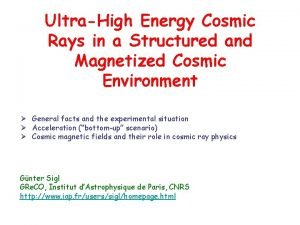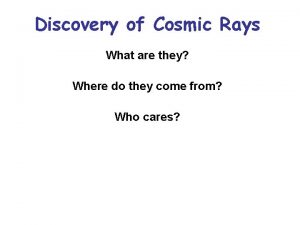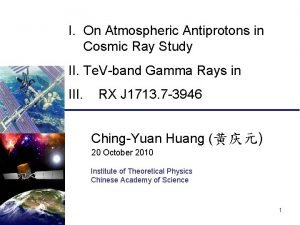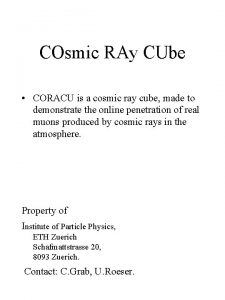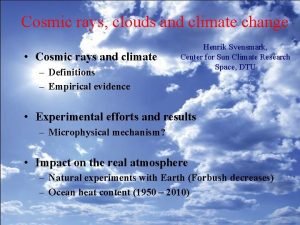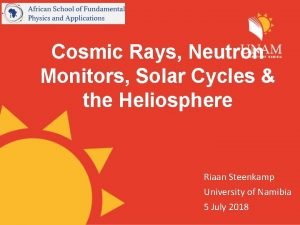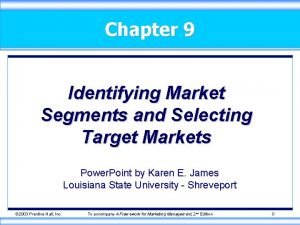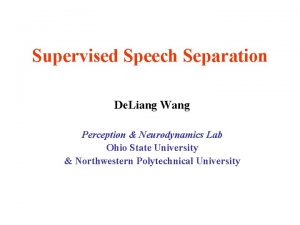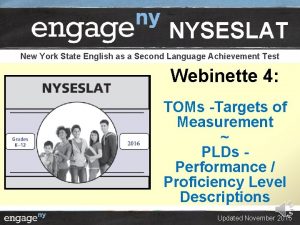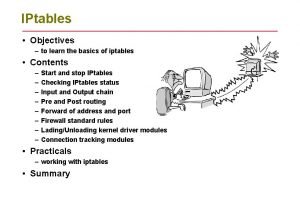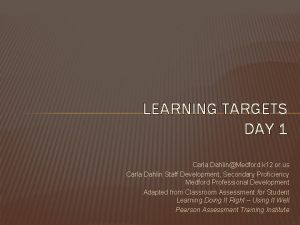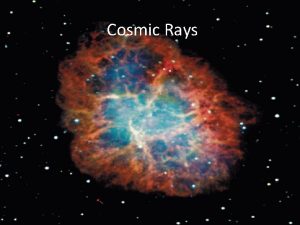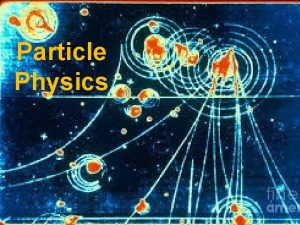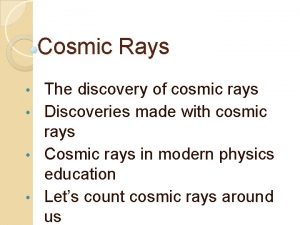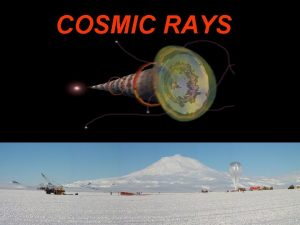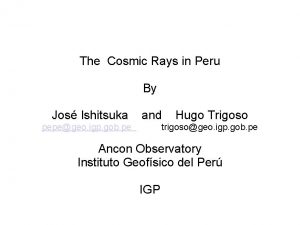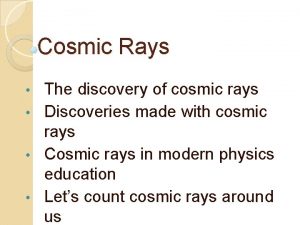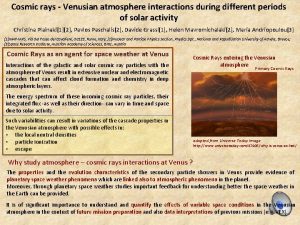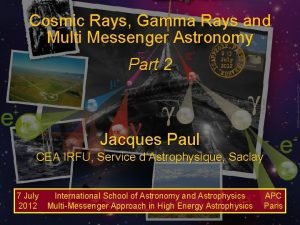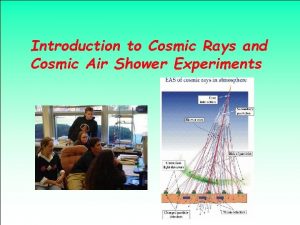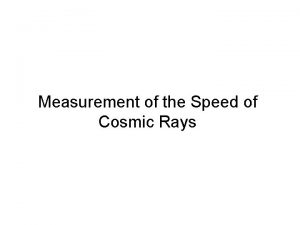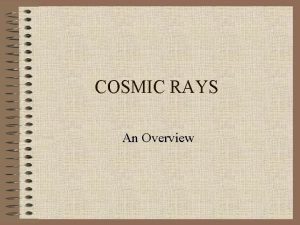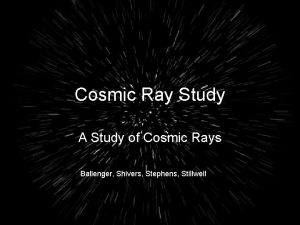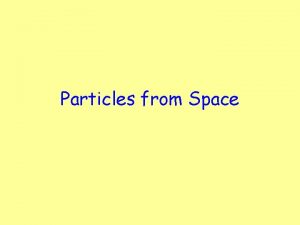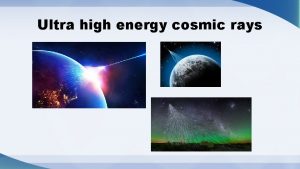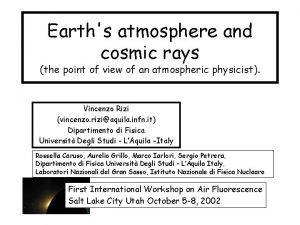Particle interactions for cosmic rays Atmosphere Nuclear targets
























- Slides: 24

Particle interactions for cosmic rays • Atmosphere – – – Nuclear targets Nuclear projectiles Forward region High energy “Minimum bias” Limited guidance from accelerator data • Astrophysics – Astrophysical uncertainties are more severe School of Cosmic-ray Astrophysics, Erice, July 4, 2004 Thomas K. Gaisser

Role of particle interactions in high-energy astrophysics Uncorrelated fluxes Hadronic interactions Air showers School of Cosmic-ray Astrophysics, Erice, July 4, 2004 Thomas K. Gaisser

Particle production: two scenarios 1. Inject beam of particles – follow secondary cascades in target – Earth or stellar atmosphere 2. Inject particles from cosmic accelerators – – diffuse in low-density gas occasional interactions School of Cosmic-ray Astrophysics, Erice, July 4, 2004 Thomas K. Gaisser

Basic formulation Equation for change in particle i in delta distance Primary particles from all directions per unit sphere School of Cosmic-ray Astrophysics, Erice, July 4, 2004 Thomas K. Gaisser

Example: production of diffuse g in ISM School of Cosmic-ray Astrophysics, Erice, July 4, 2004 Thomas K. Gaisser

p 0 2 g in diffuse ISM School of Cosmic-ray Astrophysics, Erice, July 4, 2004 Thomas K. Gaisser

Diffuse galactic g spectrum High-energy spectrum flatter than 2. 7. Possible contribution from interactions with source spectrum? School of Cosmic-ray Astrophysics, Erice, July 4, 2004 Thomas K. Gaisser

Cascades in the atmosphere School of Cosmic-ray Astrophysics, Erice, July 4, 2004 Thomas K. Gaisser

Unstable hadrons: interaction or decay? • Decay length, p+/- : gctp (cm) – in (g/cm 2) dp = rgctp = r. Eptpc / mp c 2 – lp = dp defines rcritical = 0. 018 (lp / 100 g/cm 2) / Ep • Earth’s atmosphere at X = 100 g/cm 2 : r ~ 10 -4 – this density exceeds rcritical when Ep > ep, – where ep ~ 115 Ge. V: Ep > ep, interaction > decay • Around astrophysical acceleration sites – r < rcritical even for very high Ep School of Cosmic-ray Astrophysics, Erice, July 4, 2004 Thomas K. Gaisser

Boundary conditions & scaling • Air shower, primary of mass A, energy E 0 : – N(X=0) = A d (E- E 0 /A) for nucleons – N(X=0) = 0 for all other particles • Uncorrelated flux from power-law spectrum: – N(X=0) = fp(E) = K E-(g+1) – ~ 1. 7 E-2. 7 ( cm-2 s-1 sr-1 Ge. V-1 ), top of atmosphere • Fji( Ei, Ej) has no explicit dimension, F F(x) – x = Ei/Ej & ∫…F(Ei, Ej) d. Ej / Ei ∫…F(x) dx / x 2 – Expect scaling violations from mi, LQCD ~ Ge. V School of Cosmic-ray Astrophysics, Erice, July 4, 2004 Thomas K. Gaisser

Uncorrelated fluxes in atmosphere Example: flux of nucleons l ~ constant, leading nucleon only Separate X- and E-dependence; try factorized solution, N(E, X) = f(E) g(X): Separation constant LN describes attenuation of nucleons in atmosphere School of Cosmic-ray Astrophysics, Erice, July 4, 2004 Thomas K. Gaisser

Nucleon fluxes in atmosphere Evaluate LN: Flux of nucleons: K fixed by primary spectrum at X = 0 School of Cosmic-ray Astrophysics, Erice, July 4, 2004 Thomas K. Gaisser

Comparison to proton fluxes Account for p n CAPRICE 98 (E. Mocchiutti, thesis) School of Cosmic-ray Astrophysics, Erice, July 4, 2004 Thomas K. Gaisser

Primary spectrum of nucleons • Plot shows – 5 groups of nuclei – plotted as nucleons – Heavy line is E-2. 7 fit to protons School of Cosmic-ray Astrophysics, Erice, July 4, 2004 Thomas K. Gaisser

p± m± in the atmosphere Production spectrum of p± at high energy: Decay probability per g/cm 2 m production spectrum: Note extra power of 1/E for E >> ep = 115 Ge. V School of Cosmic-ray Astrophysics, Erice, July 4, 2004 Thomas K. Gaisser

Comparison to measured m flux • High-energy analysis – o. k. for Em > Te. V • Low-energy: – dashed line neglects m decay and energy loss – solid line includes an analytic approximation of deday and energy loss by muons School of Cosmic-ray Astrophysics, Erice, July 4, 2004 Thomas K. Gaisser

Uncertainties for uncorrelated spectra • p K+ L gives dominant contribution to atmospheric neutrino flux for En > 100 Ge. V • p charm gives dominant contribution to neutrino flux for En > 10 or 100 or ? Te. V – Important as background for diffuse astrophysical neutrino flux because of harder spectrum School of Cosmic-ray Astrophysics, Erice, July 4, 2004 Thomas K. Gaisser

Calculations of air showers • Cascade programs – Corsika: full air-shower simulation is the standard – Hybrid calculations: • CASC (R. Engel, T. Stanev et al. ) uses libraries of presimulated showers at lower energy to construct a higher-energy event • SENECA (H-J. Drescher et al. ) solves CR transport Eq. numerically in intermediate region • Event generators plugged into cascade codes: – DPMjet, QGSjet, SIBYLL, VENUS, Nexus School of Cosmic-ray Astrophysics, Erice, July 4, 2004 Thomas K. Gaisser

1 Hadronic interactions at UHE • Scaling assumption for fast secondaries is equivalent to assuming distribution of final state radiation from leading di-quark is independent of beam energy • At higher energy more complex interactions may be important School of Cosmic-ray Astrophysics, Erice, July 4, 2004 x 1 x 2 s 12 = x 1 x 2 s = 2 mx 1 x 2 Elab > few Ge. V resolves quarks/gluons in target; Gluon structure function: g(x) ~ (1/x 2)p, p ~ 0. 2 …. 0. 4 E 1 Thomas K. Gaisser E 2 E 3

Geometrical model of p-A interactions {…} is probability of at least one interaction at impact parameter b s is nucleon-nucleon cross section T(b) is number of target nucleons at impact parameter b s. N is partial cross section for N wounded nucleons School of Cosmic-ray Astrophysics, Erice, July 4, 2004 Thomas K. Gaisser

Wounded nucleons & inelasticity Mean number of wounded nucleons: sp. A ~ A⅔ , so <Nw> ~ A⅓ ZNN(air) = P 1 ∫ x 1. 7 dx + P 2 ∫ x 1. 7 log(1/x) dx + ½ P 3 ∫ x 1. 7 [log(1/x)]2 dx ≈ 0. 3 School of Cosmic-ray Astrophysics, Erice, July 4, 2004 Thomas K. Gaisser

Analogy of pp and p-nucleus physics • If Atarget = Atarget(E) then x 1 – NW would increase with E – Inelasticity ≡ 1 - <x(E)> would also increase ~ A⅓ • Something like this happens with pp collisions (M. Strikman, R. Engel) • Amount of scaling violation is uncertain School of Cosmic-ray Astrophysics, Erice, July 4, 2004 x 2 s 12 = x 1 x 2 s = 2 m. Elab > few Ge. V resolves quarks/gluons in target; Gluon structure function: g(x 2) ~ (1/x 2)p, p ~ 0. 2 …. 0. 4 E 1 Thomas K. Gaisser E 2 E 3

Model-dependence of Xmax Hi. Res new composition result: transition occurs before ankle Sybil 2. 1 (some screening of gluons at small x) QGSjet (strong increase of gluon multiplicity at small x) • Xmax ~ l log(E 0 / A) with scaling • With increase of inelasticity, • Primary energy is further subdivided: • Xmax ~ l log{ E 0 / (A * (1 - <x(E)>) ) } G. Archbold, P. Sokolsky, et al. , School of Cosmic-ray Astrophysics, th ICRC, Proc. 28 Tsukuba, 2003 Erice, July 4, 2004 Thomas K. Gaisser

Example of increasing inelasticity Effect is limited because energy not carried by leading nucleon is divided among pions, which divide the remaining energy, as in scaling. Such a large change would have a significant effect on interpretation -in terms of composition -of energy in a ground array Inelasticity 1 School of Cosmic-ray Astrophysics, 0 Erice, July 15 4, 2004 17 18 16 15 16 18 Thomas K. Gaisser 19
 Cosmic rays
Cosmic rays Cosmic rays discoverer
Cosmic rays discoverer Cosmic rays
Cosmic rays Coracu
Coracu Cosmic rays and clouds
Cosmic rays and clouds Cosmic rays
Cosmic rays Lesson 15 nuclear quest nuclear reactions
Lesson 15 nuclear quest nuclear reactions Fisión nuclear vs fision nuclear
Fisión nuclear vs fision nuclear Target network
Target network Digestive system
Digestive system Identifying market segments and targets chapter 9
Identifying market segments and targets chapter 9 Racial etiquette region
Racial etiquette region On training targets for supervised speech separation
On training targets for supervised speech separation Attainment targets barbados
Attainment targets barbados Final sketch
Final sketch Learning targets
Learning targets Europe 2020 targets
Europe 2020 targets Segment invasion plan
Segment invasion plan Nyseslat targets of measurement
Nyseslat targets of measurement Brides magazine targets consumers who are in
Brides magazine targets consumers who are in How to restart iptables
How to restart iptables Identifying market segments and targets
Identifying market segments and targets Product learning target example
Product learning target example Warehouse goals and objectives
Warehouse goals and objectives Europe 2020 targets
Europe 2020 targets
